Experiencing common roofing problems? Address leaks, damaged shingles promptly to prevent water seepage. Tackle ice dam issues with proper gutter maintenance. Guarantee ventilation regulates temperature, prevents mold, and extends roof life. Watch for ponding water, tree damage, and hail damage. Clogged gutters? Clearing them prevents drainage issues. Rusty flashing? Replace with corrosion-resistant materials. Stay tuned for practical advice on DIY solutions, waterproofing techniques, and maintenance checks. Keep your roof in top shape for lasting protection.
Roof Leaks
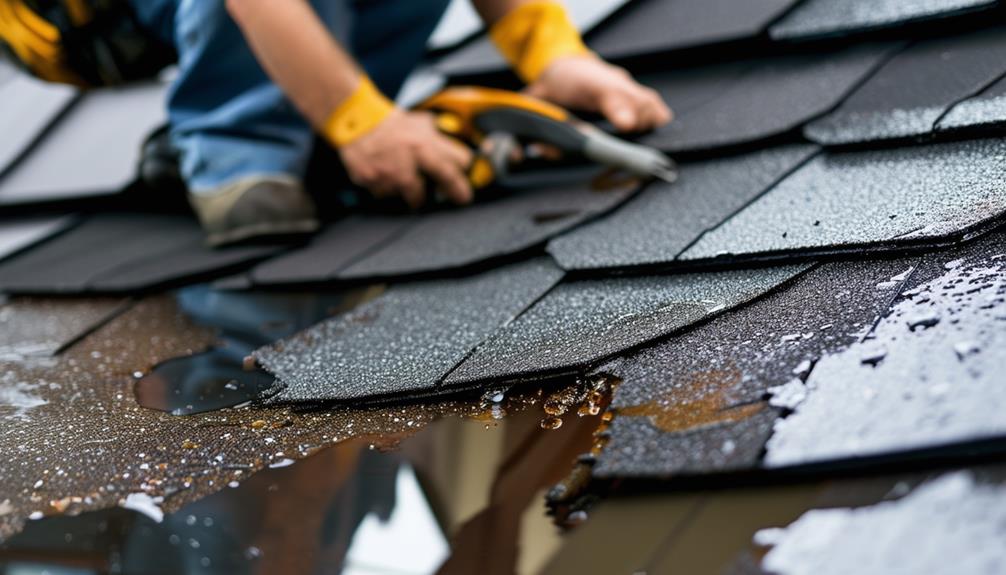
If you notice water stains on your ceiling or walls, you likely have a roof leak that needs immediate attention. Roof maintenance is important in preventing such leaks. Regularly inspect your roof for any signs of damage, such as missing or cracked shingles, as these can lead to water seepage. It's vital to address any issues promptly to avoid more extensive damage.
When faced with a roof leak, professional repairs are often the best solution. Roofing experts have the knowledge and tools to fix the problem correctly, ensuring a long-lasting repair. DIY fixes can be tempting, but they are usually temporary solutions. While applying a patch or sealant may stop the leak temporarily, it's crucial to seek professional help to address the root cause of the issue. Additionally, neglecting a proper repair can lead to more significant damage over time, increasing costs and complications. For those managing larger buildings or facilities, following commercial roof repair tips can help identify potential issues early and ensure timely maintenance. Ultimately, investing in professional services ensures both safety and the structural integrity of your property. By addressing leaks promptly, you can prevent further damage to your roof and the interior of your property. In some cases, if the damage is extensive, following a roof replacement stepbystep process might be necessary to restore your roof’s functionality and durability fully. Consulting with experienced professionals ensures that every aspect of repair or replacement is handled efficiently, giving you peace of mind and long-term protection. By following roof leak repair tips, property owners can better understand the importance of timely action and preventative maintenance. Regular inspections and prompt attention to minor issues can help avoid costly repairs in the future. Partnering with a trusted roofing contractor ensures peace of mind, knowing that your roof is in expert hands. Addressing roof issues promptly is essential to prevent further damage and maintain the value of your property. Knowing when to call roof experts can save you time and money by avoiding ineffective solutions and costly repairs down the road. If you notice persistent leaks, sagging areas, or signs of water damage, it’s a clear indication that professional intervention is needed. Moreover, professional roofing services provide transparency, with the cost of roof repairs explained upfront to help homeowners and property managers make informed decisions. This approach eliminates surprises and ensures that repairs align with the budget while addressing the core issues effectively. Taking a proactive stance by opting for expert assistance not only prevents escalating problems but also protects the value of your property in the long term. Investing in professional evaluations also helps determine whether repairs will suffice or if a complete overhaul is necessary. In cases where repairs are no longer viable, following a roof replacement stepbystep ensures that the process is thorough, efficient, and tailored to the specific needs of your property. This meticulous approach guarantees a durable and reliable roofing solution, giving you confidence in the longevity and integrity of your investment.
Damaged Shingles
Regularly inspecting your roof for damaged shingles is vital to maintaining its integrity and preventing potential leaks. Damaged shingles can occur due to various reasons such as age, weather exposure, or improper installation. If you notice cracked, curling, or missing shingles, it's important to address them promptly to avoid further damage to your roof.
When it comes to damaged shingles, timely shingle replacement is key. Ignoring damaged shingles can lead to water seepage, which may result in costly repairs. If you feel comfortable doing so, you can replace a few shingles yourself. However, for extensive damage, it's best to seek professional help to make sure the job is done correctly.
To prevent future shingle damage, regular roof maintenance is essential. Keep your roof clean of debris, trim overhanging branches, and inspect for any signs of wear and tear. By staying proactive and addressing damaged shingles promptly, you can prolong the lifespan of your roof and maintain a sturdy, leak-free shelter for years to come.
Ice Dams
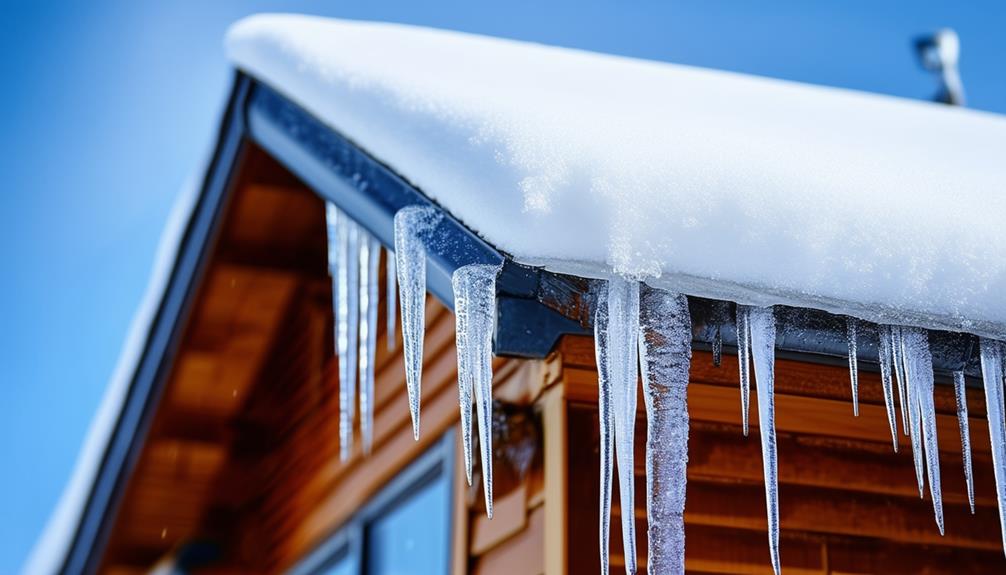
Examining your roof for ice dams during the winter season is important to prevent potential damage and leaks. Ice dams form when roof snow melts and refreezes near the roof's edge, creating a barrier that prevents proper drainage. To address this issue, start by ensuring your attic is well insulated to prevent heat from escaping and melting the snow on your roof. Additionally, proper gutter maintenance is vital. Keep your gutters clear of debris to allow melted snow to flow freely off the roof instead of accumulating and forming ice dams.
Regularly inspect your roof for any signs of ice dams, such as icicles hanging from the gutters or water stains on the ceiling. If you notice any ice dams forming, safely remove the snow from your roof using a roof rake to prevent further buildup. By staying proactive and addressing ice dams promptly, you can protect your roof from potential damage and leaks during the winter months.
Poor Ventilation
If you're experiencing issues like mold growth or high energy bills in your home, poor ventilation might be the key factor. Proper ventilation is essential for a healthy roof and home environment, as it helps regulate temperature and moisture levels. By implementing ventilation solutions such as ridge vents or soffit vents, you can improve air circulation and prevent potential roofing problems down the line.
Ventilation Importance
Inadequate ventilation can lead to a host of roofing problems, making it essential to address poor ventilation promptly. Proper ventilation offers numerous benefits, such as improving energy efficiency within your home. When your roof has adequate airflow, it helps regulate the temperature, preventing excess heat buildup in the summer and reducing moisture buildup in the winter. This balanced airflow not only keeps your living spaces more comfortable but also reduces the strain on your HVAC system, leading to potential energy savings.
Additionally, maintaining proper ventilation plays a pivotal role in extending the longevity of your roof. By allowing air to circulate effectively, ventilation helps prevent moisture buildup that can lead to mold, mildew, and rot in your roofing materials. Over time, this moisture damage can weaken the structure of your roof and shorten its lifespan. Therefore, prioritizing ventilation maintenance is key to ensuring the durability and longevity of your roof.
Ventilation Solutions
Addressing poor ventilation in your roof requires implementing effective solutions to prevent potential long-term issues. Proper ventilation is essential for maintaining the integrity of your roof and preventing problems like mold, mildew, and premature aging of roofing materials. To improve ventilation and enhance energy efficiency in your home, consider the following solutions:
- Attic Insulation: Ensuring adequate insulation in your attic can help regulate temperatures and reduce the strain on your HVAC system, leading to improved energy efficiency and better airflow within your home.
- Ridge Vents: Installing ridge vents along the peak of your roof can facilitate the escape of hot air and moisture from your attic, preventing condensation and mold growth.
- Exhaust Fans: Adding exhaust fans to your attic can further enhance ventilation by expelling stale air and promoting air circulation, helping to maintain a healthy environment and prolonging the life of your roof.
Ponding Water
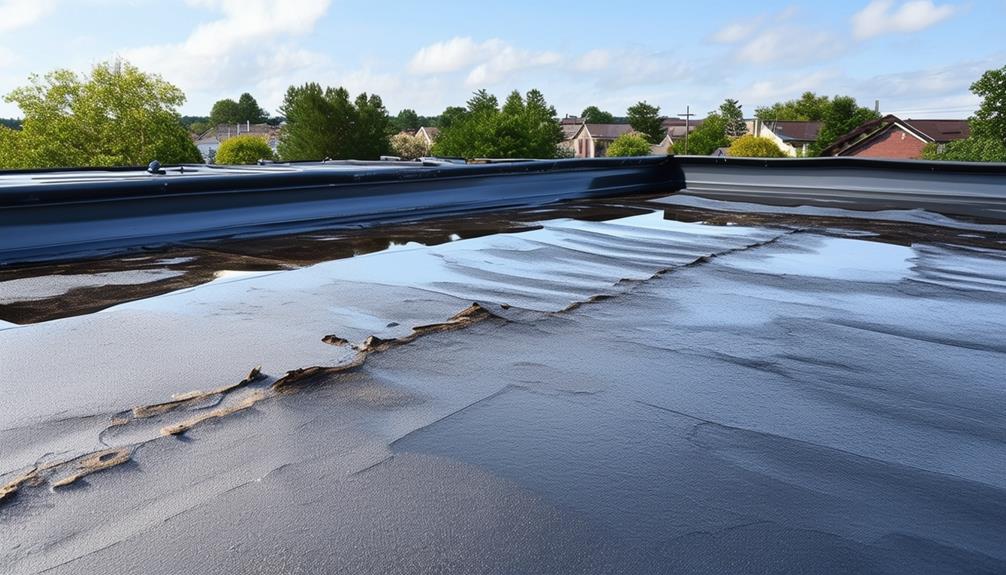
If you observe water accumulating on your roof, you might be facing ponding issues that could lead to structural damage if not taken care of promptly. Ponding water can occur due to poor drainage, sagging roofs, or clogged gutters. To prevent water accumulation, make sure your roof has proper slope and regular maintenance to avoid potential leaks and deterioration.
Causes of Ponding
Ponding on a roof typically occurs when water collects and remains stagnant due to inadequate drainage. This can lead to various issues if not addressed promptly. Here are some common causes of ponding water:
- Clogged Drains: Debris buildup in gutters and downspouts can obstruct water flow, causing ponding on the roof.
- Poor Roof Slope: Inadequate roof slope design can prevent water from properly draining off the roof surface.
- Structural Deficiencies: Weak roof structures may not adequately support the weight of standing water, leading to ponding.
To prevent ponding water, consider regular roof maintenance to make sure drains are clear and functioning correctly. Additionally, explore drainage solutions such as installing additional drains or improving the roof slope. In severe cases, roof design modifications or structural reinforcement may be necessary to prevent ponding issues in the future. Remember, addressing ponding promptly can help avoid more significant roofing problems down the line.
Preventing Water Accumulation
To prevent water accumulation on your roof, ensuring proper drainage and maintenance is vital. One key aspect to focus on is gutter maintenance. Clogged or damaged gutters can impede the flow of water off your roof, leading to ponding. Regularly inspect and clean your gutters to prevent blockages. Additionally, consider installing gutter guards to minimize debris buildup.
Another essential factor in preventing water accumulation is utilizing effective waterproofing techniques. Make sure that your roof is properly sealed to prevent leaks and water infiltration. Consider applying a waterproof coating to enhance the roof's resilience against water penetration.
Regular roof inspections can help identify potential issues before they escalate into major problems. Look for signs of ponding water, such as sagging areas or persistent damp spots. Addressing these issues promptly can help prevent water accumulation and prolong the lifespan of your roof. By staying proactive with gutter maintenance and waterproofing strategies, you can effectively prevent water accumulation on your roof.
Flashing Issues
Flashing problems on your roof can lead to water leaks and structural damage if not addressed promptly. When it comes to your roof's flashing, two common issues are rusty flashing and improper installation. Here are some key points to keep in mind:
- Rusty Flashing, Repair Options
- Rust can weaken the flashing material, leading to leaks.
- Solution: Replace the rusty flashing with new, corrosion-resistant material.
- Improper Installation, Flashing Maintenance
- Poor installation can cause flashing to lift or separate from the roof.
- Solution: Make sure flashing is properly installed and conduct regular maintenance checks to prevent issues.
Properly addressing these flashing issues is important in maintaining the integrity of your roof. By promptly repairing or replacing rusty flashing and ensuring correct installation and maintenance practices, you can safeguard your home from potential water damage and costly repairs.
Tree Damage
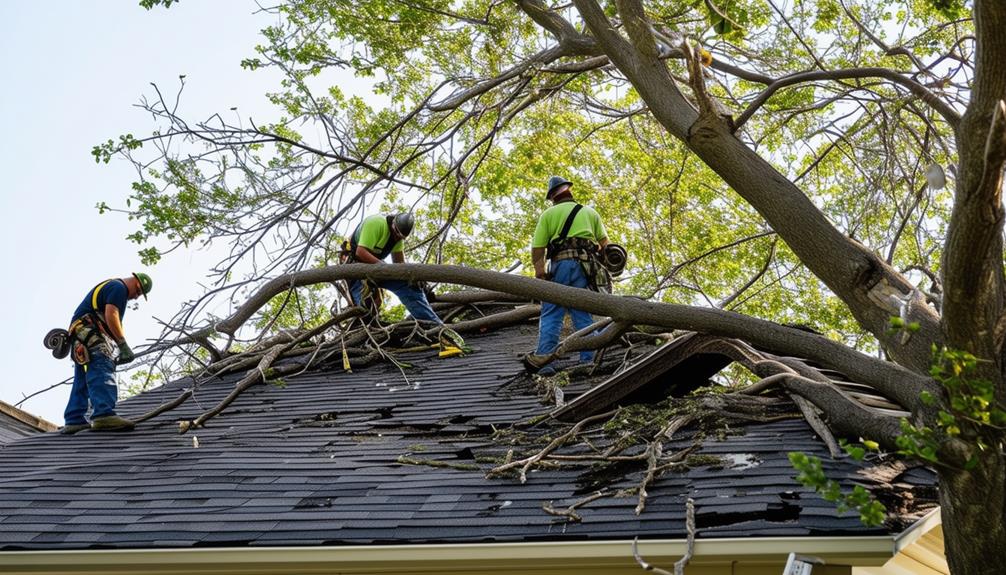
If branches are constantly scraping against your roof, you might be setting yourself up for potential tree damage. To avoid costly repairs, consider preventive tree trimming to keep branches at a safe distance. Regular maintenance can help protect your roof from unnecessary wear and tear caused by overhanging trees.
Branches on Roof
Trimming branches that hang over your roof regularly is vital to prevent potential tree damage. Tree maintenance is important for preserving the integrity of your roof. When branches are allowed to grow over your roof, they can cause a variety of issues that may lead to costly repairs. Here are some key points to keep in mind:
- Risk of Damage: Overhanging branches can scrape against the roof, damaging shingles and potentially leading to leaks.
- Pest Infestation: Branches touching the roof create a bridge for pests like squirrels, raccoons, and insects to access your home.
- Growth of Moss and Algae: Shade from branches can promote the growth of moss and algae on your roof, causing deterioration over time.
Regularly inspecting and trimming branches that pose a risk to your roof can help prevent these problems. By maintaining a clear distance between trees and your roof, you can enhance its longevity and structural integrity.
Preventive Tree Trimming
Regularly inspecting and trimming overhanging branches from trees near your roof is vital for preventing potential damage and maintaining the structural integrity of your home. Pruning benefits not only your roof but also the health of your trees. By trimming branches that are too close to your roof, you reduce the risk of them falling during storms and causing damage. This preventative measure also promotes better air circulation and sunlight exposure for your trees, enhancing their overall health.
Incorporating tree trimming into your landscape maintenance routine is essential for roof protection. Overgrown branches can scrape against your roof shingles, leading to wear and tear over time. By keeping trees properly pruned, you minimize the likelihood of debris accumulating on your roof and clogging gutters, which can result in water damage. Additionally, maintaining a safe distance between tree branches and your roof helps prevent critters from using them as pathways to access your home. Prioritizing preventive tree trimming is a practical way to safeguard your roof and preserve the beauty of your landscape.
Hail Damage
Hail damage to your roof can lead to significant issues that require prompt attention and repair. When dealing with hail damage, consider the following:
- Roofing Insurance: Contact your insurance provider to check if the hail damage is covered. This can help offset repair costs and guarantee your roof gets the necessary attention without breaking the bank.
- Roofing Contractors: Consider hiring professional roofing contractors experienced in handling hail damage. They can assess the extent of the damage accurately and provide efficient repair solutions to restore your roof's integrity.
- DIY Fixes: While some minor hail damage repairs can be done yourself, it's important to assess your skills and the severity of the damage. Simple tasks like replacing a few shingles may be manageable, but for more extensive damage, it's best to leave it to the experts to avoid further complications.
Clogged Gutters
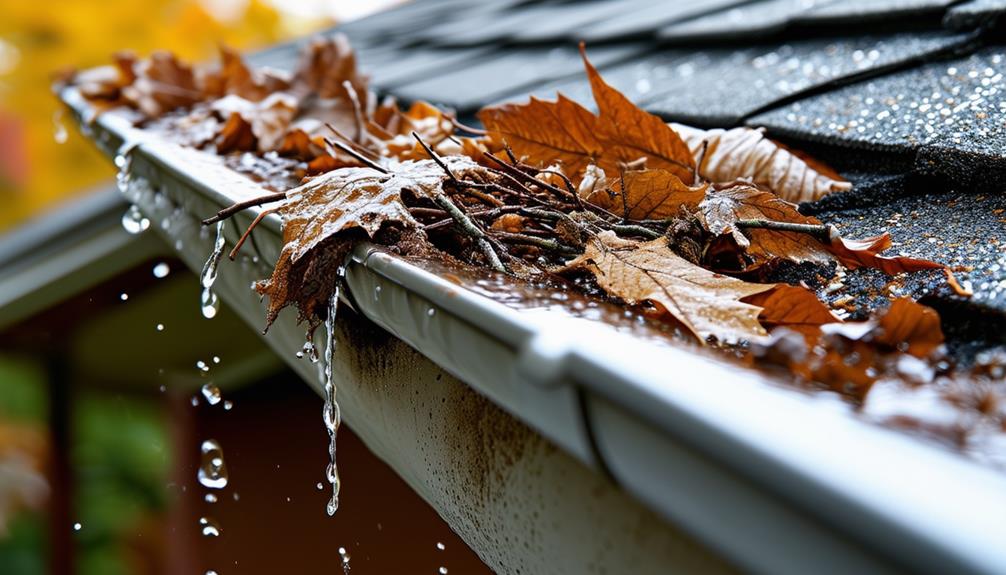
To prevent potential roofing issues, addressing clogged gutters promptly is essential to maintain the proper drainage system on your roof. Gutter maintenance is important in preventing water overflow, which can lead to various problems. When gutters are clogged with debris such as leaves, twigs, and dirt, water cannot properly flow through them. This obstruction causes water to accumulate on the roof, leading to potential leaks, water damage, and even structural issues over time.
Regular downspout cleaning is necessary to make sure that water can effectively drain away from your roof. If downspouts are blocked, it can result in drainage issues, causing water to pool on the roof and potentially seep into the underlying layers. By keeping your gutters clean and free of debris, you can prevent these issues and maintain a healthy roofing system. Periodic inspections and cleaning of gutters and downspouts will help safeguard your roof from water-related damage.
Aging Roof Materials
Monitoring the condition of your roof materials as they age is crucial for maintaining a sturdy and reliable roofing system. As time passes, your roof materials are subjected to various weathering effects that can lead to deterioration. To guarantee the longevity of your roof, consider the following:
- Regular Roof Maintenance: Conduct routine inspections to identify any signs of wear and tear early on.
- Awareness of Repair Costs: Be prepared for potential repair costs as your roof materials age.
- Weathering Effects and Maintenance Tips: Understand how weather conditions can impact your roof and implement maintenance tips to mitigate these effects.
Weathering effects such as UV exposure, moisture, and temperature fluctuations can accelerate the aging process of your roof materials. By staying proactive with roof maintenance and being conscious of potential repair costs, you can extend the lifespan of your roof and prevent costly issues down the line.
Frequently Asked Questions
How Can I Prevent Moss and Algae Growth on My Roof?
To prevent moss and algae growth on your roof, consider taking preventive measures like trimming nearby trees to increase sunlight exposure. Regularly clean your roof using gentle cleaning techniques such as scrubbing with a mixture of water and mild detergent. You can opt for natural solutions like vinegar or chemical treatments for more stubborn growth. Remember, maintaining a clean roof can help prevent moss and algae from taking hold.
What Are the Signs of a Roof Needing a Complete Replacement?
When it's time for a complete roof replacement, keep an eye out for warning signs during routine roof inspection. Look for missing or damaged shingles, sagging areas, leaks, and excessive granule loss. These issues indicate your roofing material may be reaching the end of its lifespan. Act promptly by scheduling repairs or considering a replacement to avoid further damage to your home. Regular maintenance can help extend the life of your roof. Ignoring these problems could lead to more severe structural issues, resulting in costly repairs or potential hazards. By staying vigilant and recognizing the signs you need a new roof, you can protect your investment and ensure the safety of your home. Don’t wait until small problems escalate—addressing them early can save time, money, and stress in the long run.
Is It Worth Investing in a Roof Maintenance Program?
Investing in a roof maintenance program is highly recommended. Regular roof inspections can help identify issues early, preventing costly repairs or even a full replacement down the line. With routine maintenance, you can catch problems before they escalate, saving you money in the long run. It's a proactive approach that guarantees your roof stays in top condition, extending its lifespan and protecting your home from potential damage.
Can Extreme Weather Conditions Void My Roof Warranty?
Extreme weather conditions can impact your roof warranty coverage. Certain warranties may have provisions that void warranty protection if damage is caused by severe weather. It's important to understand the terms and conditions related to extreme weather and warranty voidance. Be proactive in protecting your warranty by taking necessary precautions against the climate impact. Regular maintenance and prompt repairs can help prevent weather-related issues that may jeopardize your roof warranty.
Are There Eco-Friendly Roofing Options Available for My Home?
Looking to go green with your roof? You're in luck! There are eco-friendly roofing options available for your home. Consider green roofing alternatives like sustainable materials that are not only energy efficient but also cost-effective in the long run. By opting for these environmentally friendly choices, you can reduce your carbon footprint while enjoying the benefits of a durable and environmentally conscious roof. These types of roofing materials include recycled shingles, metal roofs, and clay or concrete tiles, all of which promote sustainability without sacrificing durability. Additionally, many of these options enhance energy efficiency by improving insulation and reducing heating and cooling costs. By exploring these innovative types of roofing materials, you can make a thoughtful investment in both your home and the planet. Additionally, investing in a green roof can enhance your home’s insulation, reducing heating and cooling costs throughout the year. To ensure your project is successful, it’s important to familiarize yourself with green roof installation steps, which include proper waterproofing, drainage systems, and selecting the right vegetation. With careful planning and execution, a green roof can transform your home while promoting sustainability.
Conclusion
So there you have it, a list of common roofing problems and solutions to keep your roof in top shape. Remember to stay on top of maintenance and repairs to avoid costly issues down the road. Because let's face it, dealing with a leaky roof or damaged shingles is definitely not the way you want to spend your weekends. Keep your roof well-maintained and you'll thank yourself later.




